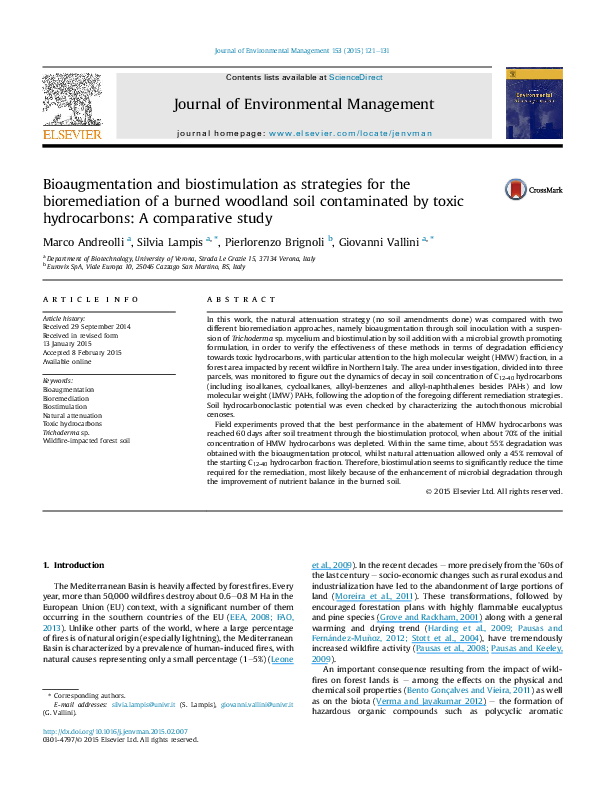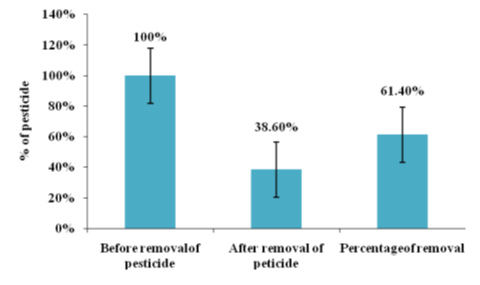
Jul 15, · A General Essay on Bioremediation of Contaminated Soil. Dana L. Donlon and J. W. Bauder, Professor, Montana State University-Bozeman. MSSE Graduate Student and Professor, respectively. Bioremediation is defined as use of biological processes to degrade, break down, transform, and/or essentially remove contaminants or impairments of quality from soil and Apr 30, · A General Essay on Bioremediation of Contaminated Soil Dana L. Donlon and J. W. Bauder, Professor, Montana State University-Bozeman MSSE Graduate Student and Professor, respectively Bioremediation is defined as use of biological processes to degrade, break down, transform, and/or essentially remove contaminants or impairments of quality from Jun 01, · Bioremediation which occurs without human intervention other than monitoring is often called natural attenuation. This natural attenuation relies on natural conditions and behavior of soil microorganisms that are indigenous to soil. Biostimulation also utilizes indigenous microbial populations to remediate contaminated soils
Bioremediation is a natural process which relies on bacteria, fungi, and plants to alter contaminants as these organisms carry out their normal life functions.
Metabolic processes of these organisms are capable of using chemical contaminants as an energy source, rendering the contaminants harmless or less toxic products in most cases. This paper summarizes the general processes of bioremediation within the soil environment, focusing on biodegradation of petroleum hydrocarbons. The effect of soil conditions on rate of biodegradation of hydrocarbons is addressed.
Further, limitations and potential of both ex situ and in situ bioremediation as viable alternatives to conventional remediation are explained and addressed. Many substances known to have toxic properties have been introduced into the environment through human activity. These substances range in degree of toxicity and danger to human health. Many of these substances either immediately or ultimately come in contact with and are sequestered by soil.
Proficient in: Anaerobic Respiration. Task done as described and better, responded to all my questions promptly too! Conventional methods to remove, reduce, or mitigate toxic substances introduced into soil or ground water via anthropogenic activities and processes include pump and treat systems, soil vapor extraction, incineration, and containment. The emerging science and technology of bioremediation offers an alternative method to detoxify contaminants. Bioremediation which occurs without human intervention other than monitoring is a general essay on bioremediation of contaminated soil called natural attenuation.
This natural attenuation relies on natural conditions and behavior of soil microorganisms that are indigenous to soil, a general essay on bioremediation of contaminated soil. Biostimulation also utilizes indigenous microbial populations to remediate contaminated soils.
Biostimulation consists of adding nutrients and other substances to soil to catalyze natural attenuation processes. Bioaugmentation involves introduction of exogenic microorganisms sourced from outside the soil environment capable of detoxifying a particular contaminant, sometimes employing genetically altered microorganisms Biobasics, During bioremediation, microbes utilize chemical contaminants in the soil as an energy source and, through oxidation-reduction reactions, metabolize the target contaminant into a general essay on bioremediation of contaminated soil energy for microbes.
By-products metabolites released back into the environment are typically in a less toxic form than the parent contaminants. For example, petroleum hydrocarbons can be degraded by microorganisms in the presence of oxygen through aerobic respiration. The hydrocarbon loses electrons and is oxidized while oxygen gains electrons and is reduced. The result is formation of carbon dioxide and water Nester et al.
When oxygen is limited in supply or absent, as in saturated or anaerobic soils or lake sediment, anaerobic without oxygen respiration prevails.
Generally, inorganic compounds such as nitrate, a general essay on bioremediation of contaminated soil, ferric iron, a general essay on bioremediation of contaminated soil, manganese, or carbon dioxide serve as terminal electron acceptors to facilitate biodegradation State of Mississippi, Department of Environmental Quality, Three primary ingredients for bioremediation are: 1 presence of a contaminant, 2 an electron acceptor, and 3 presence of microorganisms that are capable of degrading the specific contaminant.
Generally, a contaminant is more easily and quickly degraded if it is a naturally occurring compound in the environment, or chemically similar to a naturally occurring compound, because microorganisms capable of its biodegradation are more likely to have evolved State of Mississippi, Department of Environmental Quality, Petroleum hydrocarbons are naturally occurring chemicals; therefore, microorganisms which are capable of attenuating or degrading hydrocarbons exist in the environment.
Development of biodegradation technologies of synthetic chemicals such DDT is dependent on outcomes of research that searches for natural or genetically improved strains of microorganisms to degrade such contaminants into less toxic forms. Microorganisms have limits of tolerance for particular environmental conditions, as well as optimal conditions for pinnacle performance.
Factors that affect success and rate of microbial biodegradation are nutrient availability, moisture content, pH, and temperature of the soil matrix. Inorganic nutrients including, but not limited to, nitrogen, and phosphorus are necessary for microbial activity and cell growth.
However, it has also been shown that excessive amounts of nitrogen in soil cause microbial inhibition. Walworth et al. Addition of phosphorus has benefits similar to that of nitrogen, but also results in similar limitations when applied in excess State of Mississippi, Department of Environmental Quality, All soil microorganisms require moisture for cell growth and function. Availability of water affects diffusion of water and soluble nutrients into and out of microorganism cells.
However, excess moisture, such as in saturated soil, is undesirable because it reduces the amount of available oxygen for aerobic respiration. Anaerobic respiration, which produces less energy for microorganisms than aerobic respiration and slows the rate of biodegradation, becomes the predominant process. Soil pH is important because most microbial species can survive only within a certain pH range.
Furthermore, soil pH can affect availability of nutrients. Temperature influences rate of biodegradation by controlling rate of enzymatic reactions within microorganisms.
There is an upper limit to the a general essay on bioremediation of contaminated soil that microorganisms can withstand. Most bacteria found in soil, including many bacteria that degrade petroleum hydrocarbons, are mesophiles which have an optimum temperature ranging from 25 degree C to 45 degree C Nester et al. Thermophilic bacteria those which survive and thrive at relatively high temperatures which are normally found in hot springs and compost heaps exist indigenously a general essay on bioremediation of contaminated soil cool soil environments and can be activated to degrade hydrocarbons with an increase in temperature to 60 degree C.
Contaminants can adsorb to soil particles, rendering some contaminants unavailable to microorganisms for biodegradation. Thus, in some circumstances, bioavailability of contaminants depends not only on the nature of the contaminant but also on soil type. Hydrophobic contaminants, like petroleum hydrocarbons, have low solubility in water and tend to adsorb strongly in soil with high organic matter content.
In such cases, surfactants are utilized as part of the bioremediation process to increase solubility and mobility of these contaminants State of Mississippi, Department of Environmental Quality, Additional research findings of the existence of thermophilic bacteria in cool soil also suggest that high temperatures enhance the rate of biodegradation by increasing the bioavailability of contaminants.
It is suggested that contaminants adsorbed to soil particles are mobilized and their solubility increased by high temperatures Perfumo et al.
Soil type is an important consideration when determining the best suited bioremediation approach to a particular situation.
In situ bioremediation refers to treatment of soil in place. It is imperative that oxygen and nutrients are distributed evenly throughout the contaminated soil.
Soil texture directly affects the utility of bioventing, n as much as permeability of soil to air and water is a function of soil texture. Fine-textured soils like clays have low permeability, which prevents biovented oxygen and nutrients from dispersing throughout the soil.
It is also difficult to control moisture content in fine textured soils because their smaller pores and high surface area allow it to retain water, a general essay on bioremediation of contaminated soil.
Bioventing is well-suited for well-drained, medium, and coarse-textured soils. In situ bioremediation causes minimal disturbance to the environment at the contamination site. In addition, it incurs less cost than conventional soil remediation or removal and replacement treatments because there is no transport of contaminated materials for off-site treatment.
However, in situ bioremediation has some limitations: 1 it is not suitable for all soils, 2 complete degradation is difficult to achieve, and 3 natural conditions i. emperature are hard to control for optimal biodegradation. Ex situ bioremediation, in which contaminated soil is excavated and treated elsewhere, is an alternative.
Ex situ bioremediation approaches include use of bioreactors, landfarming, a general essay on bioremediation of contaminated soil, and biopiles. In the use of a bioreactor, contaminated soil is mixed with water and nutrients and the mixture is agitated by a mechanical bioreactor to stimulate action of microorganisms.
In each of these methods, conditions need to be monitored and adjusted regularly for optimal biodegradation. Use of landfarming and biopiles also present the issue of monitoring and containing volatilization of contaminants. Like in situ methods, ex situ bioremediation techniques generally cost less than conventional techniques and apply natural methods. If the challenges of bioremediation, particularly of in situ techniques, can be overcome, bioremediation has potential to provide a low cost, non-intrusive, natural method to render toxic substances in soil less harmful or harmless over time.
Currently, research is being conducted to improve and overcome limitations that hinder bioremediation of petroleum hydrocarbons. On a broader scope, much research has been and continues to be developed enhance understanding of the essence of microbial behavior as microbes interact with various toxic contaminants.
Additional research continues to evaluate conditions for successful introduction of exogenic and genetically engineered microbes into a contaminated environment, and how to translate success in the laboratory to success in the field US DOE, Biobasics: The Science and the Issues. Anderson, C. Evans Roberts Jr. Pearsall, and Martha T. Microbiology: A Human Perspective. New York: McGraw-Hill. Perfumo, Amedea, Ibrahim M. Banat, Roger Marchant, and Luigi Vezzulli. State of Mississippi, a general essay on bioremediation of contaminated soil.
Department of Environmental Quality. Fundamental Principles of Bioremediation. April United States. Department of Energy, Office of Science. Bioremediation Research Needs. Environmental Protection Agency. Walworth, James, Andrew Pond, Ian Snape, John Rayner, Susan Ferguson, and Paul Harvey.
Cite this page Bioremediation of Contaminated Soil: Review of Related Literature. Bioremediation of Contaminated Soil: Review of Related Literature. Accessed October 6, Bioremediation of Contaminated Soil: Review of Related Literature Categories: Anaerobic Respiration Literature Microorganisms Nature. Download paper. Review, Pages 8 words. Turn in your highest-quality paper Get a qualified writer to help you with. Get quality help now. Verified writer.
Get to Know The Price Estimate For Your Paper. Deadline: 10 days left.
Bioremediation of Gasoline Contaminated Soil
, time: 13:18
Jun 01, · Bioremediation which occurs without human intervention other than monitoring is often called natural attenuation. This natural attenuation relies on natural conditions and behavior of soil microorganisms that are indigenous to soil. Biostimulation also utilizes indigenous microbial populations to remediate contaminated soils Jul 15, · A General Essay on Bioremediation of Contaminated Soil. Dana L. Donlon and J. W. Bauder, Professor, Montana State University-Bozeman. MSSE Graduate Student and Professor, respectively. Bioremediation is defined as use of biological processes to degrade, break down, transform, and/or essentially remove contaminants or impairments of quality from soil and Apr 30, · A General Essay on Bioremediation of Contaminated Soil Dana L. Donlon and J. W. Bauder, Professor, Montana State University-Bozeman MSSE Graduate Student and Professor, respectively Bioremediation is defined as use of biological processes to degrade, break down, transform, and/or essentially remove contaminants or impairments of quality from
No comments:
Post a Comment